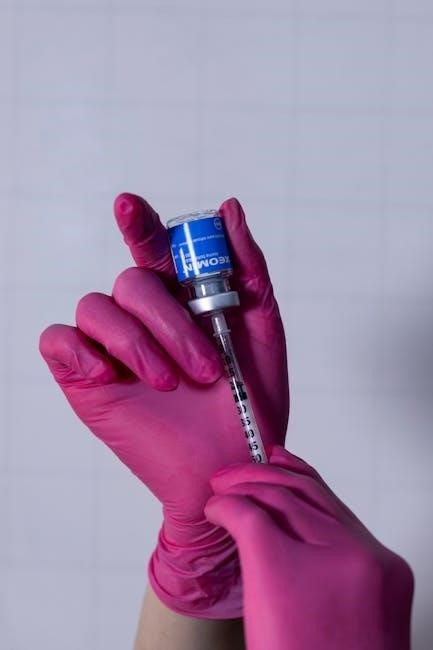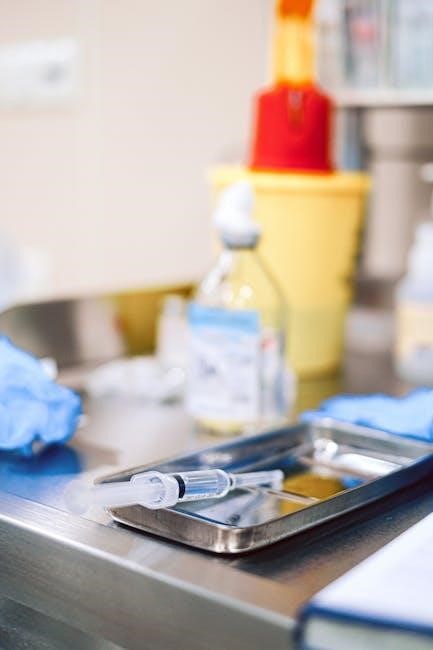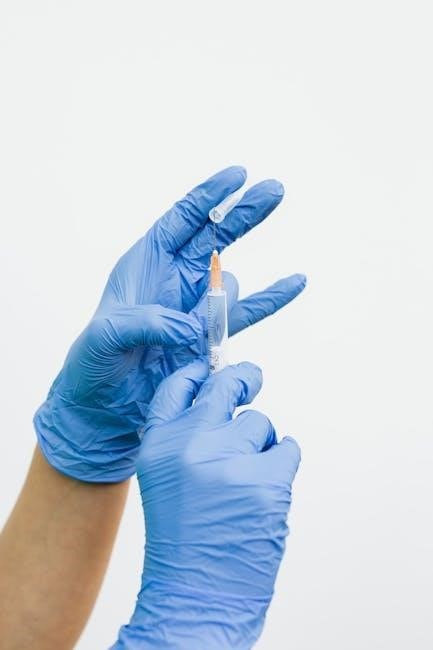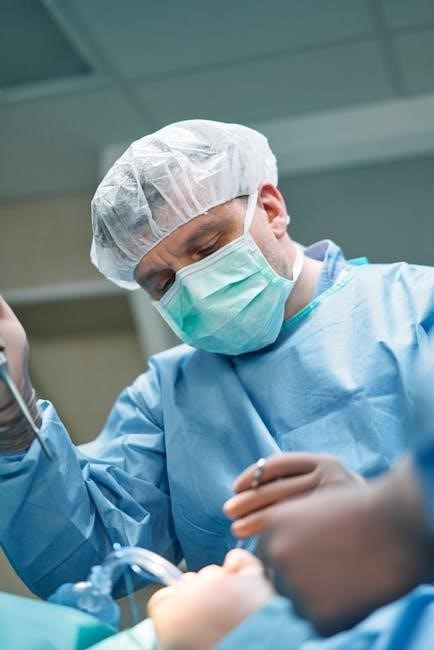
The 7th edition of Medical Assisting: Administrative and Clinical Procedures offers a comprehensive guide, authored by Kathryn Booth and Leesa Whicker, covering essential skills for modern medical assistants;
Overview of the Book and Its Authors
Medical Assisting: Administrative and Clinical Procedures, 7th Edition, authored by Kathryn Booth and Leesa Whicker, is a comprehensive textbook designed for medical assisting education․ Published by McGraw Hill in 2020, this edition provides detailed coverage of both administrative and clinical procedures, ensuring a well-rounded understanding of the field․ The authors, both experienced in medical assisting education, bring practical expertise to the content․ The book aligns with key accrediting standards, including ABHES, CAAHEP, and MAERB competencies, making it a valuable resource for students and professionals alike․

Key Features of the 7th Edition
The 7th edition of Medical Assisting: Administrative and Clinical Procedures offers enhanced content, including updated infection control protocols and new technologies in medical assisting․ It provides a strong focus on anatomy and physiology, essential for clinical procedures․ The book aligns with accrediting standards such as ABHES, CAAHEP, and MAERB, ensuring comprehensive coverage of required competencies․ Additional features include test-taking strategies and a mapping guide for clinical topics, aiding students in exam preparation․ The 7th edition also incorporates CLIA-waived procedures and emphasizes patient communication and office management skills, making it a robust resource for both students and practicing medical assistants․

Administrative Procedures in Medical Assisting
Administrative procedures include office management, patient communication, scheduling, and medical billing․ These tasks ensure smooth operation of healthcare settings, requiring strong organizational and interpersonal skills․
Office Management and Patient Communication
The 7th edition emphasizes office management and patient communication as foundational skills for medical assistants․ Topics include scheduling appointments, managing records, and handling front-office responsibilities․ Effective communication strategies are explored to enhance patient interactions and ensure clear understanding of procedures․ The book covers interpersonal skills, telephone techniques, and cultural competence, essential for building strong patient relationships․ Real-world scenarios and practical exercises help students master these administrative tasks․ Authors Kathryn Booth and Leesa Whicker provide insights into maintaining a professional and efficient office environment․ This section aligns with industry standards, ensuring students are well-prepared to handle administrative duties while fostering positive patient outcomes and office productivity․
Medical Billing, Coding, and Insurance
The 7th edition delves into medical billing, coding, and insurance processes, ensuring students understand the financial aspects of healthcare․ It covers current coding systems, including ICD-10 and CPT, and explains how to accurately prepare and submit insurance claims․ The book emphasizes compliance with regulations and provides practical exercises to master billing procedures․ Real-world examples and case studies help students grasp complex scenarios․ The section aligns with industry standards, preparing learners for professional roles in medical billing and insurance․ Authors Kathryn Booth and Leesa Whicker ensure clarity and relevance, making this section a valuable resource for mastering the administrative side of medical assisting․

Clinical Procedures in Medical Assisting
The 7th edition covers essential clinical procedures, including patient assessment, vital signs, and diagnostic testing․ It emphasizes infection control and safety, preparing students for real-world clinical tasks․
Patient Assessment and Vital Signs
The 7th edition provides a detailed approach to patient assessment, focusing on techniques for accurately measuring vital signs such as temperature, pulse, respiration, and blood pressure․ It includes visual aids and case studies to enhance understanding of normal and abnormal findings․ Students learn to document observations effectively and recognize signs of distress․ The text emphasizes communication skills to ensure patient comfort during assessments․ New content covers the latest technologies in monitoring vital signs, offering practical insights for real-world applications․ This section is crucial for developing competency in clinical skills, aligning with accreditation standards for medical assisting education․
Diagnostic Testing and CLIA-Waived Procedures
The 7th edition thoroughly covers diagnostic testing and CLIA-waived procedures, essential for medical assistants in clinical settings․ It explains point-of-care testing, such as glucose and urine analysis, with step-by-step instructions․ The text highlights proper techniques for collecting and handling specimens to ensure accurate results․ Emphasis is placed on understanding CLIA-waived regulations and quality control measures․ New content addresses emerging technologies, like rapid diagnostic kits, and their integration into practice․ Practical scenarios and illustrations aid comprehension, helping students master these critical skills․ This section aligns with accreditation standards, preparing learners for real-world applications in diagnostic testing and maintaining patient safety․

Updates in the 7th Edition
The 7th edition introduces new technologies, enhanced infection control protocols, and updated clinical procedures, ensuring alignment with modern medical assisting standards and competencies․
New Technologies and Equipment in Medical Assisting
The 7th edition highlights advancements in medical technologies, such as digital health records and telemedicine platforms, which streamline patient care and administrative tasks․ It also covers the latest diagnostic tools, including portable devices for CLIA-waived procedures, enabling medical assistants to perform tests efficiently․ The integration of electronic medical records (EMRs) is emphasized, providing guidance on data entry, patient privacy, and interoperability․ Additionally, the book explores emerging equipment like automated vital sign monitors and point-of-care testing devices, ensuring students are well-prepared to use modern tools in clinical settings․ These updates reflect the evolving landscape of healthcare technology, equipping future medical assistants with essential skills for success․
Enhanced Focus on Infection Control and Safety
The 7th edition places a strong emphasis on infection control and safety protocols, addressing critical measures to prevent the spread of pathogens in healthcare settings․ It incorporates updated guidelines from organizations such as the CDC and OSHA, ensuring compliance with current standards․ The text explores best practices for proper hand hygiene, use of personal protective equipment (PPE), and sterilization techniques․ Additionally, it covers emerging challenges, such as antibiotic resistance and pandemic preparedness, providing medical assistants with practical strategies to maintain a safe environment․ This enhanced focus ensures that students are well-equipped to prioritize patient and staff safety, reflecting the growing importance of infection control in modern healthcare․

The Importance of Anatomy and Physiology in Medical Assisting
Understanding anatomy and physiology is crucial for medical assistants, as it provides the foundation for performing clinical procedures and interpreting diagnostic results effectively․
Understanding Body Systems for Clinical Procedures
Understanding body systems is vital for medical assistants to perform clinical procedures effectively․ The 7th edition provides detailed insights into each system, enabling a deeper comprehension of how they function and interact․

Competency Mapping and Accreditation Standards
The 7th edition aligns with ABHES, CAAHEP, and MAERB competencies, ensuring comprehensive coverage of clinical and administrative skills for accredited medical assisting programs․
Alignment with ABHES, CAAHEP, and MAERB Competencies

The 7th edition of Medical Assisting: Administrative and Clinical Procedures is meticulously aligned with the competencies set by ABHES, CAAHEP, and MAERB․ These accrediting bodies ensure that medical assisting education meets rigorous standards, preparing students for both administrative and clinical roles․ The textbook integrates these competencies seamlessly, covering essential skills such as patient communication, medical billing, and diagnostic testing․ By adhering to these standards, the book provides a comprehensive foundation for future medical assistants, ensuring they are well-prepared to meet the demands of modern healthcare․ This alignment also supports students in developing the proficiency needed for certification and lifelong professional growth in the field․

Learning Resources and Test-Taking Strategies
The 7th edition provides robust learning tools, including practice exams and flashcards, to enhance exam preparation․ Strategies for effective test-taking are emphasized, ensuring success in certification․
Maximizing the Use of the Book for Exam Preparation
The 7th edition of Medical Assisting: Administrative and Clinical Procedures is designed to optimize exam preparation with detailed practice exams, flashcards, and test-taking strategies․ These resources help students reinforce key concepts and improve problem-solving skills․ The book aligns with accreditation standards, ensuring comprehensive coverage of critical topics․ By utilizing the companion study materials, learners can identify areas for improvement and focus their efforts effectively․ The structured approach to exam preparation builds confidence and competence, making it an invaluable tool for success in certification exams and beyond․ This edition serves as a complete guide to mastering the skills needed for modern medical assisting․
The 7th edition of Medical Assisting: Administrative and Clinical Procedures is a vital resource, offering comprehensive updates and enhanced focus on modern standards, ensuring well-rounded education for future professionals․
How This Edition Supports Modern Medical Assisting Education
The 7th edition of Medical Assisting: Administrative and Clinical Procedures aligns with current standards, providing updated content on infection control, new technologies, and CLIA-waived procedures․ This ensures students gain practical skills and theoretical knowledge necessary for real-world applications․ Enhanced mapping to ABHES, CAAHEP, and MAERB competencies guarantees comprehensive preparation for certification exams․ The inclusion of test-taking strategies and learning resources maximizes exam readiness․ By addressing modern challenges and advancements, this edition equips future medical assistants with the expertise needed to excel in dynamic healthcare environments, fostering a strong foundation for lifelong learning and professional success․